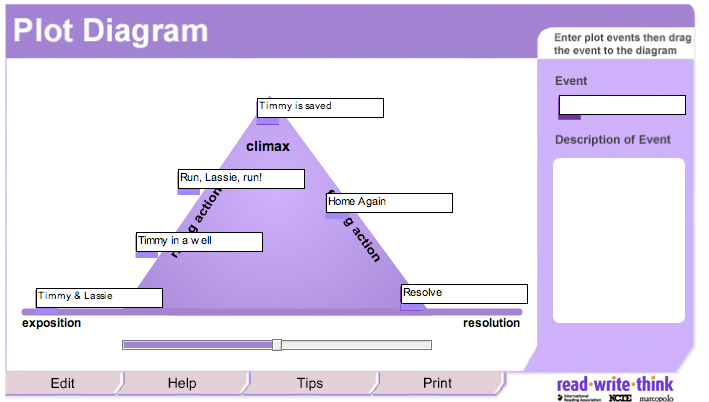Plot and Theme
| Site: | MN Partnership for Collaborative Curriculum |
| Course: | English 9 (B) |
| Book: | Plot and Theme |
| Printed by: | Guest user |
| Date: | Sunday, January 4, 2026, 10:20 PM |
Description
Plot and Theme
Plot
Plot

The plot is the events that happen within the story. Sometimes parts of the plot are only referred to indirectly, other times they are directly a part of the story.
The time in which it takes a plot to happen can vary; sometimes an entire plot takes place in a few minutes, while in other stories it takes place over years. Some stories will have fewer plot details, usually so the author can spend more time on description. Subplots are shorter plots that take place within a story.
Using Romeo and Juliet as an example, the plot is the details of the houses of Montague and Capulet fighting, Romeo's fight with Tybalt, his exile and the tragic ending. Finding a subplot in Romeo and Juliet is a little controversial. Some might argue that there is no subplot - that every detail goes to support the main plot of Romeo and Juliet's love. Others might identify a part of the story as a subplot such as Mercutio and Tybalt's fight.
Sources
Photo courtesy of umjanedoan/Flickr
Plot Diagram
Plot Diagram
Learning to diagram a plot is a simple activity and helps the reader to recognize key events in the story. There are five parts to plot. The first is called beginning, or exposition. Here we are introduced to the setting, characters and conflict. Second is rising action where the conflict intensifies, and the characters interact. Third is the climax, which usually takes place toward the end of the book. The climax is where the conlfict risest to its highest point. Fourth is falling action, when the intensity of the conflict settles down. And fifth and final is the end, or resolution. This is where the conflict has been resolved, and the characters are likely changed or affected by the outcome.Below is an example of a plot diagram.

Theme
Theme
The theme of a story is the idea that the text is trying to explore. Theme is different from plot or conflict, because the theme is the purpose of the plot or conflict. Many stories have more than one theme, and the theme is not always directly said in the text. For example, in To Kill a Mockingbird, possible themes could be courage, family, prejudice, and maturity. In Romeo and Juliet, possible themes include love, sacrifice, hate or fate. In The Call of the Wild, possible themes might include friendship, man vs. nature, sacrifice, working towards a goal, etc.Finding the theme can be easy or difficult. The key is to look at the entire text, not just a particular plot element. Ask: "Why did the author write this story?" Remember, there may be more than one answer.